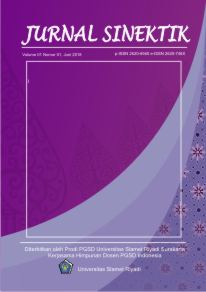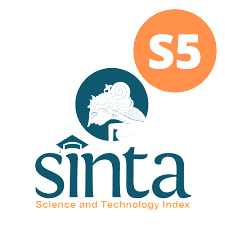PENGARUH MEDIA DAKOTA TERHADAP KEMAMPUAN BERPIKIR KRITIS SISWA MATERI KPK DAN FPB MATA PELAJARAN MATEMATIKA KELAS IV SDN 01 GEMUHBLANTEN
DOI:
https://doi.org/10.33061/js.v2i2.3328Keywords:
dakota media, critical thinking abilityAbstract
The purpose of this study was to determine the effect of dakota media on students' critical thinking skills in KPK and FPB material. This type of research is quantitative with the research design of One-Group Pretest-Posttest Design. The population were all fourth grade students of SDN 01 Gemuhblanten. The sample taken was 19 fourth grade students. The data in this study were obtained through tests, interviews, observations, and documentation. The results of hypothesis testing on students' critical thinking abilities show that tcount 19.851 and ttable 2.086 with a significancy level of 5%. Because tcount> ttable is 19.851> 2.086, then Ha is accepted, that is, dacota media has an effect on students' critical thinking abilities.
References
Aspriliana, Rizka. 2018. Pengaruh Media Dakon Bilangan Terhadap Hasil Belajar FPB dan KPK Siswa SDN 34 Pontianak. Jurnal Pendidikan dan Pembelajaran Khatulistiwa. Volume 7 Nomor 3.
Fisher, Alec. 2009. Berpikir Kritis. Jakarta : Erlangga
Kuswana, Wowo Sunaryo. 2012. Taksonomi Kognitif Perkembangan Ragam Berpikir. Bandung: Rosda
Munadi, Yudhi. 2013. Media Pembelajaran: Sebuah Pedekatan Baru. Jakarta: Referensi
Oktiana Dwi Putra Herawati, Rusdy Siroj, dan Djahir Basir. 2010. Pengaruh Pembelajaran Problem Posing Terhadap Kemampuan Pemahaman Konsep Matematika Siswa Kelas XI IPA SMA Negeri 6 Palembang. Jurnal Pendidikan Matematika. Volume 4 No 1.
Sugiyono. 2016. Metode Penelitian Kualitatif, Kuantitatif, dan R&D. Bandung : Alfabeta
Sundayana, Rostina. 2015. Media dan Alat Peraga dalam Pembelajaran Matematika : untuk Guru, calon Guru, Orangtua, dan Para Pecinta Matematika. Bandung : Alfabeta
Downloads
Published
Issue
Section
License
Authors who publish this journal agree to the following terms:
- Authors retain copyright and grant the journal right of first publication with the work simultaneously licensed under a Creative Commons Attribution License that allows others to share the work with an acknowledgement of the work's authorship and initial publication in this journal.
- Authors can separately make additional contractual arrangements for non-exclusive distribution published by the journal (e.g., publish it in a book), with an acknowledgement of its initial publication in this journal.
- Authors are allowed and encouraged to send their work via online (e.g., in the institutional repositories or their website) after published by the journal.














